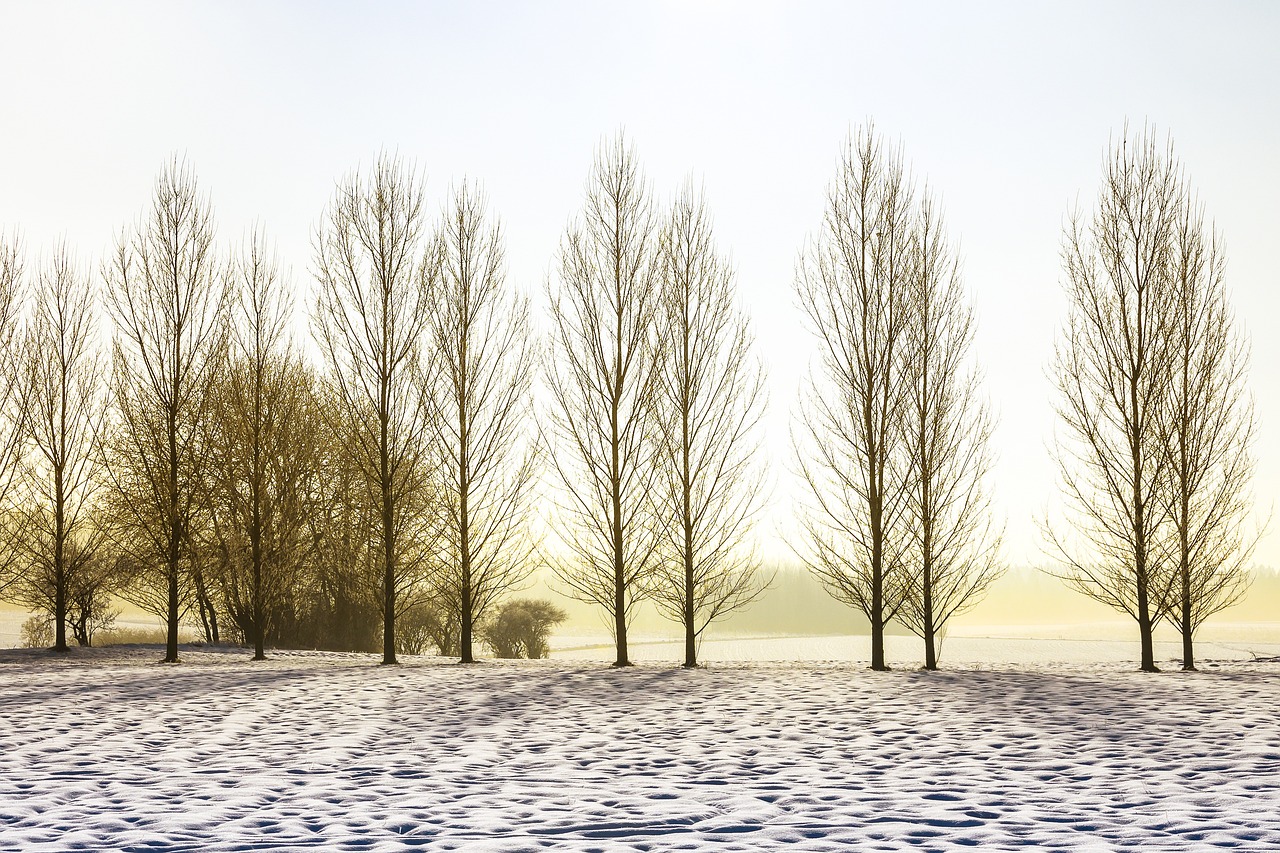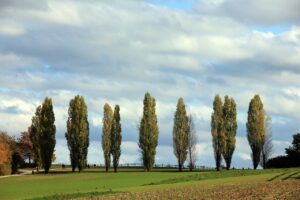Poplar
Overview
Poplar trees, part of the Salicaceae family, are known for their quick growth and varying uses from firewood to shade trees. These hardy giants, which span roughly 35 species, are easily recognized by their distinctive bark and leaves, and thrive from cool to warm regions with well-drained soils. While they’re adaptable and have practical benefits, considerations regarding space and root systems are critical when planting.

Characteristics
Known for its large stature, distinctive bark and leaf shapes, and clusters of drooping flowers.
Region
USDA Hardiness Zones 3-9, particularly in the flood plains of the southern United States.
Natural Habitat
Poplar trees are commonly found in flood plains, along rivers, and in moist forested areas.
Cultivation
Prefers full sun, requires well-drained soil, and needs approximately 10 gallons of water weekly after planting.
Uses and Benefits
Poplar trees offer a multitude of benefits that make them a valuable addition to any landscape. These fast-growing trees provide high-quality wood, particularly from species like the Balsam Poplar (Populus balsamifera), which is prized for its usefulness in construction and paper production1. Beyond their value as a timber resource, Poplars also serve as effective natural barriers due to their rapid vertical growth. Many people choose to plant these trees for privacy or as windbreaks, creating a green screen that offers both form and function.
Certain Poplar species are well-suited for adding a lush, green element to landscapes while providing ample shade. However, it’s important to consider their extensive root systems and potential for spreading, which can pose challenges in smaller spaces or near structures2. Poplars are highly adaptable trees that can thrive in a wide range of climates, from the cool temperatures of zone 3 to the warmer conditions of zone 913. This versatility makes them a popular choice for gardeners and landscapers across various regions.
In addition to their practical applications, Poplars also offer ecological benefits. They serve as habitat for various wildlife species and can help stabilize soil and prevent erosion. Some key advantages of Poplar trees include:
- Fast growth rate, providing quick results for landscaping or timber production
- Versatile wood that can be used for construction, paper production, and other industries
- Effective as natural privacy screens or windbreaks
- Adaptable to a wide range of climates and soil types
- Ecological benefits such as wildlife habitat and soil stabilization
When considering Poplars for your landscape or garden, be sure to research the specific species and cultivars that are best suited to your climate, soil type, and available space. With proper planning and care, these remarkable trees can provide a lifetime of beauty, shade, and practical benefits.

Cultivation Tips
Growing Poplar trees starts by choosing the right species for your space and needs. These adaptable trees favor a sunny spot with well-drained soil. When planting, make sure the rootball is level with the ground and backfill using native soil. To help the tree establish, create a shallow basin around the root zone to direct water to the roots; they’ll need about 10 gallons per week during the first growing season3.
Some Poplar species, like the gray poplar (Populus canescens), have extensive root systems. To avoid potential damage, plant them at least 30 feet away from buildings, septic systems, and confined garden areas4. Poplars grow quickly, so ensure there’s ample space for the mature tree’s height and spread.
Tips for a thriving Poplar tree:
- Plant in spring or fall when the weather is cool
- Stake young trees to provide support in windy conditions
- Prune annually in late winter to maintain shape and remove damaged branches
- Mulch around the base to retain moisture and suppress weeds
- Monitor for common issues like leaf spots, cankers, and borers
With proper care, Poplars can provide shade, windbreaks, and quick-growing biomass for firewood or pulpwood production. These versatile trees make a functional and attractive addition to suitable landscapes.
Seasonal Considerations
When planting Poplar trees, it’s important to consider the seasonal conditions that will support their growth. Spring is an ideal time to plant, as the soil is workable and temperatures are mild. This allows the tree to establish its roots before summer heat arrives. Fall planting is also an option, giving the Poplar time to settle in before winter dormancy.
Regardless of the season, keep these tips in mind:
- Poplars need consistent moisture, especially during dry spells. Provide about 10 gallons of water weekly to the root zone.3
- Apply a layer of organic mulch around the base of the tree to retain moisture and regulate soil temperature.
- Protect young Poplars from winter damage by wrapping the trunk in tree wrap or using plastic tree guards.
As your Poplar grows, it may need seasonal pruning. The best time for this is late winter or early spring, before new growth emerges. This helps maintain the tree’s shape and removes any damaged or diseased branches.
With proper seasonal care, your Poplar tree will thrive and provide beauty and function to your landscape for years to come. Just remember to give it the space it needs, as some species like Populus ×canescens (gray poplar) have extensive root systems.4

Issues and Troubleshooting
While Poplar trees can be a fantastic addition to your landscape, it’s important to be aware of some common challenges. Populus ×canescens, also known as Gray Poplars, have a tendency to sucker—sending up shoots from their extensive root system—that may become invasive4. This can be particularly problematic in the following situations:
- Near buildings or structures
- In smaller gardens where space is limited
To prevent suckering from becoming an issue, consider these tips:
- Regular pruning: Consistently remove any suckers that appear to keep them under control.
- Careful planting location: Choose a spot with ample space for the tree’s root system to spread without interfering with nearby plants or structures.
In addition to suckering, it’s crucial to provide your Poplar with the right growing conditions. Aim for:
- A balanced amount of sunlight
- Well-drained soil
By meeting the tree’s needs and considering your local climate, you’ll help keep your Poplar healthy and thriving3. With proper care and attention, you can enjoy the shade and beauty these robust trees offer for years to come.
History and Folklore
Poplars have been interwoven into the myths, legends, and everyday lives of diverse cultures for centuries. The ancient Greeks associated the poplar with Herakles (Hercules), who wore a crown of poplar leaves when he retrieved Cerberus from Hades 1. This tale led to the silver poplar being seen as a symbol of courage and endurance in the face of adversity.
In Celtic mythology, the poplar was linked to the Otherworld and the dead. The Irish believed that poplar branches hung around a grave would prevent the deceased from rising as a ghost. Similarly, in Slavic folklore, poplar trees were thought to be home to spirits and demons, with the rustling of their leaves believed to be whispers from the supernatural realm.
Practicality and folklore often intertwined, as seen in the use of poplar wood. Its lightweight yet durable properties made it ideal for various applications:
- Roman legions used poplar to construct shield handles due to its resilience and shock-absorbing qualities.
- In ancient Greece, poplar was favored for writing tablets because of its smooth surface and light color, which made text easier to read.
- Native Americans, such as the Salish people, utilized poplar bark to create baskets, ropes, and even clothing.
The poplar’s association with resurrection and rebirth can be traced to several cultures. In ancient Egypt, the tree was linked to the god Osiris, who was believed to have been resurrected by his wife Isis. Similarly, in Christianity, the poplar is sometimes connected to the cross on which Jesus was crucified, symbolizing salvation and new beginnings.
Throughout history, the poplar has been a silent witness to human civilization, its leaves rustling with stories of courage, spirituality, and ingenuity. From the mythical realms of ancient Greece to the practical craftsmanship of Native Americans, the poplar has left an indelible mark on the folklore and traditions of countless cultures.
References
1. Leafy Place, https://leafyplace.com/poplar-trees/
2. The Tree Center, https://www.thetreecenter.com/your-guide-to-poplar-trees/
3. Better Homes & Gardens, https://www.bhg.com/how-to-plant-and-grow-poplar-trees-7551451
4. The Spruce, https://www.thespruce.com/popular-poplar-trees-5093743
5. American Gardener, https://americangardener.net/poplar-tree-identification-uses-how-to-grow-care/
Image Credit: fotoblend
Image Credit: Saramukitza
Image Credit: AnnaER
Nicolas Duval
Nicolas is a passionate advocate for nature and the art of wildcrafting. His dedication shines through in Wildcraftia, a website he meticulously crafted to serve as a haven for nature enthusiasts worldwide. Driven by a deep appreciation for nature’s connection to humanity, Nicolas embarked on his journey in 2011 with SmokableHerbs, a platform showcasing his love for nature’s bounty. Building upon this foundation, he established Smokably, a thriving online store offering premium herbs and blends to a global audience.
